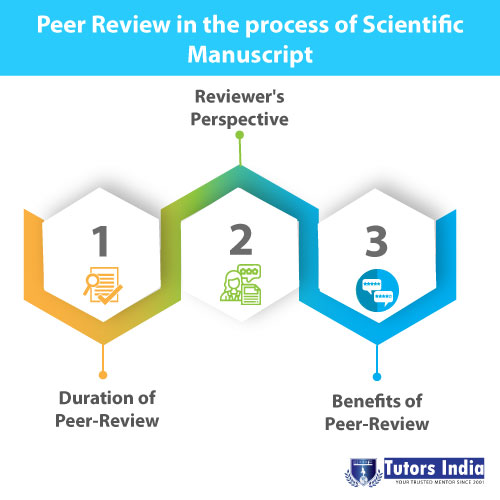Peer-Review in the process of writing Scientific Manuscript
In Brief
- Researchers across the world intensely recognize the value of the peer-review process. However, the swiftly rising volume of submissions is situating this important and time-consuming process, which involves a corroboration of new research, under immense pressure.
- The absence of monetary compensation or even acknowledgment for reviewers, and the necessity to balance manuscript reviews with their individual work, is taking a toll on the peer review process and leading to reviewer fatigue.
- This summary report includes only a small fraction of the data accessible in the full report, which interested readers can find on the Publishing Research Consortium website. This article helps you proceed with the research paper for a peer- reviewed journal.

Introduction
Peer review, recognized as refereeing in some academic fields, a process of subjecting an author’s scholarly work, research or ideas to the scrutiny of others who are experts in the same field. Scholarly publication is the means by which new work is communicated and peer review is an important part of this process. Peer review is a significant part of the quality control mechanism that is used to determine what is published, and what is not. In the medical community, most scholarly work or research will not be seriously considered until it has been validated by peer review. Furthermore, the peer review process acts as a filter for interest and relevance to the field being targeted by a journal. Therefore, peer review should serve several purposes.
The key functions of the peer review process are to help conserve standards and make certain that the reporting of research work is as truthful and precise as possible. Peer review contributes to the ongoing process used by individual clinicians to assess what information to believe and what to view with skepticism. This occurs because individual clinicians with varied levels of experience know that a peer reviewed, published manuscript has been reviewed and deemed worthy by others, often with greater or more varied experience than they possess.
Duration of Peer Review
The peer review process inevitably takes time. The survey looked at this from the perspective of authors, reviewers and editors. Authors reported that the peer review process took an average of 80 days, with the longest times in humanities and social sciences. They were evenly split on whether or not the length of time from submission to decision was satisfactory, and it was clear that the authors experiencing the longest delays were the least satisfied. For review times of 30 days or less, about two-thirds of respondents were satisfied with the time; this drops sharply at 3–6 months to 19%, and to 9% for review times in excess of 6 months.

Reviewer’s Perspective
On average, reviewers said that they reviewed about 8 papers in the previous 12 months. This average figure disguises the distribution of reviews among reviewers. We identified the group of reviewers who reported doing 6 or more reviews in the last12 months (‘active reviewers’), and this group managed nearly twice as many papers as the average. This meant that although active reviewers made up just 44% of reviewers in our survey, they were responsible for 79% of reviews. Reviewers say that they took about 24 days to complete their last review, with 85% reporting that they took 30 days or less. They spent a median 5 hours (mean 9 hours) per review. Active reviewers and those in the English-speaking regions reported spending considerably less time per review than less frequent reviewers and those from Asia and the Rest of world.
Benefits of Peer Review
In one view, there are benefits for all players in the system: editors are supported in their decisions by the views of experts; authors benefit from the assistance offered by reviewers and from the status conferred on them by publication in journals with high peer review standards; readers benefit because of the filtering that peer review provides and by the ‘seal of approval’ that peer review is thought to provide; and even reviewers benefit to some extent. Looking beyond the interests of the particular stakeholders, there are three main benefits advocated for peer review:
• Improvement in the quality of published papers;
• filtering of the output of papers to the benefit of readers;
• A ‘seal of approval’ that the published work meets certain standards, in particular for lay readers.
Conclusion
While the peer review process is unlikely to change the basic nature of a given submission, in many cases the authors may add analysis or results, clarify thoughts or parameters, revise the statistical testing methods, increase the number of subjects, or lengthen the time of clinical follow‐up in response to reviewer’s requests. Most typically, thoughtful comments provided by reviewers lead to improvements in the presentation of the work in several ways. Our experts help you to reach out for writing scientific manuscript.
Reference
- Harutyunyan, L., & Poveda, M. F. (2018). Students’ Perception of Peer Review in an EFL Classroom. English language teaching, 11(4), 138-151.
- Ware, M. (2008). Peer review: benefits, perceptions and alternatives (p. 2008). London: Publishing Research Consortium.

 Previous Post
Previous Post Next Post
Next Post